
The Mrs. Gould’s sunbird (Aethopyga gouldiae) is a species of bird in the Nectariniidae family. Male 14–15 cm, 6·5–8 g; female 10 cm, 6·1 g. Relatively short-billed sunbird, male long-tailed. Male nominate race has metallic violet crown. It is found in Bangladesh, Bhutan, China, Hong Kong, India, Laos, Myanmar, Nepal, Thailand, and Vietnam. Its natural habitats are temperate forests and subtropical or tropical moist montane forests. Found in Various forest types, including oak forest, ridgetop forest and conifers, scrub. The Irish ornithologist Nicholas Vigors named the bird after Elizabeth Gould, a British artist and the wife of the naturalist John Gould. Diet is Nectar, spiders (Araneae) and insects. Forages at all levels, typically among lower branches and undergrowth; often at mistletoes. Resident; Seasonal altitudinal movements in higher parts of range; some post-breeding movement in NE India. Not globally threatened. Not globally threatened. Generally uncommon in India, but locally common in East; widespread but uncommon in Nepal; frequent in Bhutan; not uncommon in Myanmar.
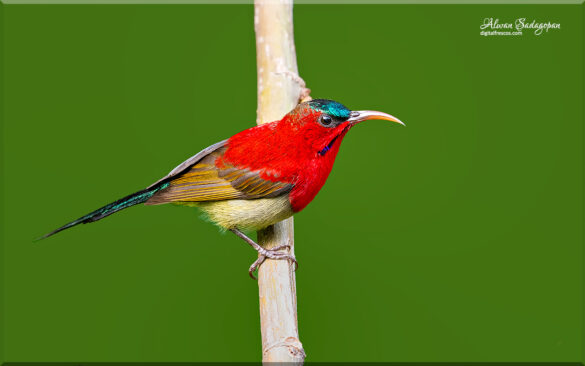
The crimson sunbird is a species of bird in the sunbird family which feed largely on nectar, although they will also take insects, especially when feeding the young. Crimson sunbirds are tiny, only 11 cm long. Male 11·7–15 cm, 4·8–9 g; female 10 cm, 5–6·9 g. Male nominate race has forehead to centre of crown glossed purple-green. They have medium-length thin down-curved bills and brush-tipped tubular tongues, both adaptations to their nectar feeding. The adult male has a crimson breast and maroon back. The rump is yellow and the belly is olive. The female has an olive-green back, yellowish breast and white tips to the outer tail feathers. Most species can take nectar by hovering like a hummingbird, but usually perch to feed most of the time. Diet is Insects, spiders (Araneae) and nectar. Forages in pairs and singly, also in family parties, usually low down but occasionally in canopy. Various forest types, including mangroves, heavily disturbed and regenerating secondary forests. Seasonal altitudinal movements in Himalayas. Sight record from Pakistan (Islamabad) in winter, Resident. Not globally threatened (Least Concern). Generally fairly common to common throughout wide range; uncommon to rare on Butung (off SE Sulawesi). Occurs in many protected areas.
The yellow-cheeked tit (Machlolophus spilonotus) is a species of bird in the family Paridae. It is also known as the yellow-cheeked tit, Chinese yellow-cheeked tit, the black-spotted yellow tit, or the Chinese yellow tit. This 13·5–15·5 cm; 18–23 g. Medium-sized to large size tit with erect black crest and eyestripe and yellow cheeks. It is found in Bangladesh, Bhutan, China, Hong Kong, India, Laos, Burma, Nepal, Thailand, and Vietnam.Its natural habitats are subtropical or tropical moist lowland forest and subtropical or tropical moist montane forest. Diet not well known, but includes small invertebrates and larvae, including spiders (Araneae), also buds and some fruit and berries. Resident; also short-distance altitudinal migrant, descending to lower levels in non-breeding season. Not globally threatened. Common or locally common to rare. Scarce or rare in Himalayas, but locally common in NE Indian hill states and Myanmar. It is classified as least concern by IUCN.
The black-throated prinia (Prinia atrogularis) is a species of bird in the Cisticolidae family. 14–16 cm; 8–16 g. A large prinia with rather slender, slightly decurved bill and very long graduated, pointed tail. It is found from eastern Nepal, through Bangladesh to Eastern India (Arunachal Pradesh). It was formerly considered conspecific with the hill prinia. The habitat is mainly Open grassy hillsides and mountainsides with scrubby cover and scattered shrubs; scrubby forest. Food chiefly insects and their larvae. Normally encountered singly or in pairs, and usually very skulking, but forages also in noisy family. Seasonal altitudinal movements in Himalayas. Sight record from Pakistan (Islamabad) in winter, Generally considered resident, but a degree of altitudinal migration. Not globally threatened. Not globally threatened (Least Concern). Restricted-range species: confined to the Eastern Himalayas EBA. Common to locally common over its range.
The black-throated prinia (Prinia atrogularis) is a species of bird in the Cisticolidae family. 14–16 cm; 8–16 g. A large prinia with rather slender, slightly decurved bill and very long graduated, pointed tail. It is found from eastern Nepal, through Bangladesh to Eastern India (Arunachal Pradesh). It was formerly considered conspecific with the hill prinia. The habitat is mainly Open grassy hillsides and mountainsides with scrubby cover and scattered shrubs; scrubby forest. Food chiefly insects and their larvae. Normally encountered singly or in pairs, and usually very skulking, but forages also in noisy family. Seasonal altitudinal movements in Himalayas. Sight record from Pakistan (Islamabad) in winter, Generally considered resident, but a degree of altitudinal migration. Not globally threatened. Not globally threatened (Least Concern). Restricted-range species: confined to the Eastern Himalayas EBA. Common to locally common over its range.
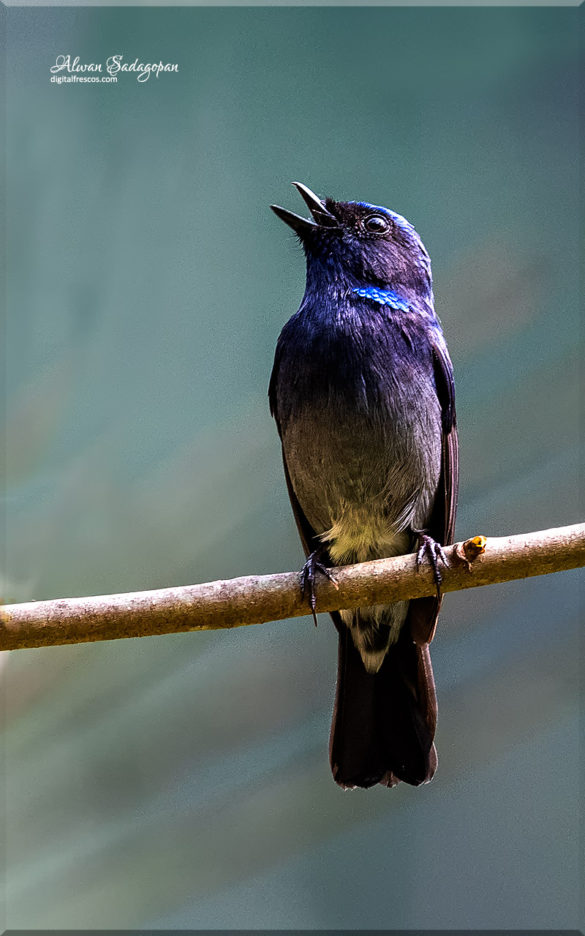
The small niltava (Niltava macgrigoriae) is a species of bird in the family Muscicapidae, native to the Indian subcontinent and Southeast Asia. 11–14 cm; 11–13 g. Small niltava, a smaller version (about half-size) of N. grandis. Male nominate race has bright pale blue forehead reaching to eye. It is found in Bangladesh, Bhutan, India, Laos, Myanmar, Nepal, Thailand, Tibet and Vietnam. Its natural habitat is subtropical or tropical moist montane forests. More specifically the Edges and clearings in humid submontane and montane broadleaf evergreen forest. Diet small invertebrates, including flies (Diptera), and some fruit, e.g. berries. Solitary or in pairs. Fairly shy and inconspicuous. HResident and short-distance altitudinal migrant. Locally, makes post-breeding descent to lower altitude. Not globally threatened. Fairly common or common in Himalayas, and fairly common in China. Uncommon in NW Thailand; uncommon or fairly common in N & E Myanmar. It is classified as least concern by IUCN.
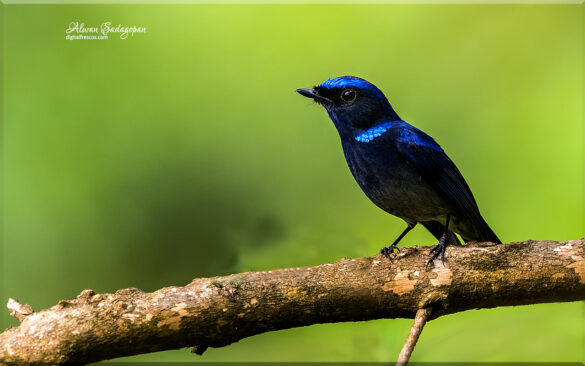
The small niltava (Niltava macgrigoriae) is a species of bird in the family Muscicapidae, native to the Indian subcontinent and Southeast Asia. 11–14 cm; 11–13 g. Small niltava, a smaller version (about half-size) of N. grandis. Male nominate race has bright pale blue forehead reaching to eye. It is found in Bangladesh, Bhutan, India, Laos, Myanmar, Nepal, Thailand, Tibet and Vietnam. Its natural habitat is subtropical or tropical moist montane forests. More specifically the Edges and clearings in humid submontane and montane broadleaf evergreen forest. Diet small invertebrates, including flies (Diptera), and some fruit, e.g. berries. Solitary or in pairs. Fairly shy and inconspicuous. HResident and short-distance altitudinal migrant. Locally, makes post-breeding descent to lower altitude. Not globally threatened. Fairly common or common in Himalayas, and fairly common in China. Uncommon in NW Thailand; uncommon or fairly common in N & E Myanmar. It is classified as least concern by IUCN.
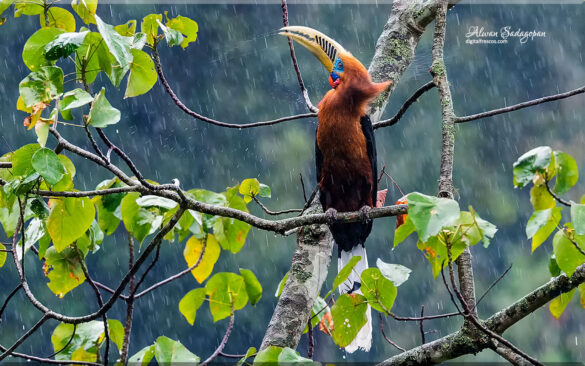
The rufous-necked hornbill (Aceros nipalensis) is a species of hornbill in northeastern India, especially in Arunachal Pradesh, Indian Subcontinent and Southeast Asia. It is locally extinct in Nepal due to hunting and significant loss of habitat. There are < 10,000 adults left in the wild. With a length of about 117 centimetres (46 in), it is among the largest Bucerotine hornbills. The underparts, neck and head are rich rufous in the male, but black in the female. The head, neck, and lower body of the male are coloured rufous, with deeper colouration on the flanks and abdomen. The middle primaries and the lower half of the tail are tipped white. The rest of the hornbill’s plumage is a glossy dark-green and black. The lower tail-covert feathers are coloured chestnut mixed with black. The female, on the other hand, is black, except for the end-portion of her tail and the tips of the middle primaries, which are white. Juvenile hornbills resemble adults of the same sex, but lack the ridges at the base of the upper beak. The beak lacks a true caique but is thickened at its base. It has a number of dark ridges on the upper beak which […]
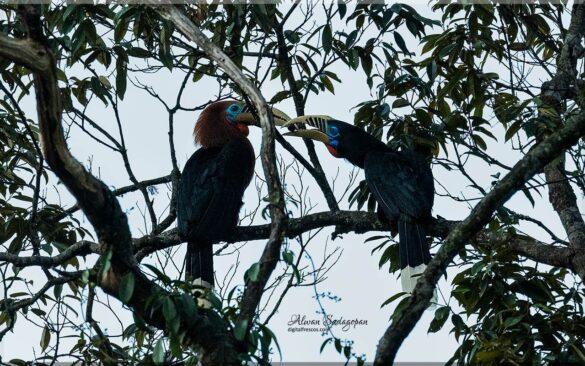
The rufous-necked hornbill (Aceros nipalensis) is a species of hornbill in northeastern India, especially in Arunachal Pradesh, Indian Subcontinent and Southeast Asia. It is locally extinct in Nepal due to hunting and significant loss of habitat. There are < 10,000 adults left in the wild. With a length of about 117 centimetres (46 in), it is among the largest Bucerotine hornbills. The underparts, neck and head are rich rufous in the male, but black in the female. The head, neck, and lower body of the male are coloured rufous, with deeper colouration on the flanks and abdomen. The middle primaries and the lower half of the tail are tipped white. The rest of the hornbill’s plumage is a glossy dark-green and black. The lower tail-covert feathers are coloured chestnut mixed with black. The female, on the other hand, is black, except for the end-portion of her tail and the tips of the middle primaries, which are white. Juvenile hornbills resemble adults of the same sex, but lack the ridges at the base of the upper beak. The beak lacks a true caique but is thickened at its base. It has a number of dark ridges on the upper beak which […]
The rusty-fronted barwing (Actinodura egertoni) is a species of bird in the laughingthrush family, Leiothrichidae. 21·5–23·5 cm; 31–42 g. Long-tailed, unstreaked barwing with brownish-grey head and crest and chestnut forehead, face and chin. It is found in Southeast Asia from the Himalayas to north-eastern Myanmar. Its natural habitats are temperate forests and subtropical or tropical moist montane forests. Dense undergrowth, scrub-jungle, forest edge, shrubbery and scrub in warm broadleaf evergreen forests. Diet is Insects, including grasshoppers (Orthopterra) and ants (Formicidae); also berries, including those of wild strawberries. Resident. Movements to lower elevations during harsh winter weather reported, but none clearly established. Not globally threatened. In Central Nepal rare and local, becoming slowly commoner to Eastern of range in Himalayas. Frequent in Bhutan but less common in West; near Zhemgang.
The rufous-vented yuhina (Yuhina occipitalis) is a bird species in the white-eye family Zosteropidae. 12–14 cm; 10–16 g. Fairly large greyish-brown yuhina with rufous nape and vent, prominent crest, slightly forked tail. Nominate race has side of forehead pale. It is found in along the northern parts of the Indian subcontinent, primarily in the Eastern Himalayas, and ranges across Bhutan, India, Tibet, Myanmar, and Nepal. Its natural habitat is subtropical or tropical moist montane forests, Broadleaf evergreen forest, particularly oak-rhododendron forest. Diet is Mostly insects in summer. Partial to visiting rhododendron blossoms in search of nectar and probably insects; berries eaten in winter. RResident; some altitudinal displacement to lower levels in winter. Not globally threatened. Common in Nepal, including in Langtang National Park. Common in Bhutan, and present in Thrumshingla National Park. In India, locally fairly common.

The white-crested laughingthrush (Garrulax leucolophus) is a member of the family Leiothrichidae. It is a highly social and vocal bird found in forest and scrub from the Himalayan foothills to Southeast Asia. The white-crested laughingthrush is a member of the family Leiothrichidae, recently split from the Old Word babbler family, Timaliidae. Its scientific name Garrulax leucolophus comes from Latin garrire “to chatter”, in reference to its very vocal nature, and from Greek leukós “white” and lophos “crest”. Like other birds in its genus, G. leucolophus has a stocky build, with strong blackish legs and bill, rounded tail, and voluminous plumage. Its body length averages 30 cm, and its tail ranges from 13 to 15 cm. It is named after its characteristic white hood and raised crest. It is also easily recognizable due to its broad and elongated black eye-mask. The mantle, back and underparts from the lower breast down are rufescent, contrasting with the white head, throat and upper chest and fading into darker olive-brown on the tail and upper wings. The nape is light gray. Similarly to other laughingthrushes, G. leucolophus is omnivorous and opportunistic. It subsists mostly on invertebrates such as beetles, spiders, flies, mealworms and caterpillars, snails […]
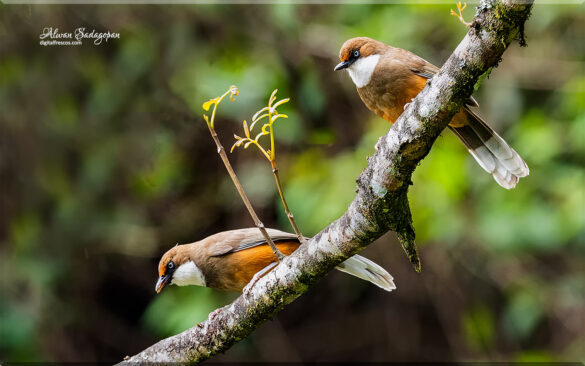
The white-throated laughingthrush (Pterorhinus albogularis) is a species of passerine bird in the family Leiothrichidae. 28–30·5 cm; 78–150 g. Rather large, dull brown laughingthrush with white breast, rufescent-buff lower underparts and broad white tail tips. It is found mainly in the northern regions of the Indian subcontinent, primarily the Himalayas, and some adjoining and disjunct areas. It ranges across Afghanistan, Bhutan, India, Myanmar, Nepal, Pakistan, Tibet and Vietnam. Its natural habitat is Broadleaf evergreen forest, deciduous forest and coniferous forest, open secondary growth, scrub lands. Mainly insects; outside breeding season also berries and seeds. Gregarious, even in breeding season, occurring in flocks of 6–15. Resident and minor partial altitudinal migrant. In Bhutan moves from 1400–3200 m in summer. Not globally threatened. In Pakistan, rare and local, possibly now extinct. Common and widespread in Nepal. Abundant in Bhutan. It is classified as least concern by IUCN.

The blood pheasant (Ithaginis cruentus) is the only species in genus Ithaginis of the pheasant family. This relatively small, short-tailed pheasant is widespread and fairly common in eastern Himalayas, ranging across India, Nepal, Bhutan, China and northern Myanmar. The blood pheasant was the national bird of the former Kingdom of Sikkim, and remains Sikkim’s state bird. Blood pheasants have the size of a small fowl, about 17 in (43 cm) in length with a short convex, very strong black bill, feathered between bill and eye, and a small crest of various coloured feathers. The colour of the plumage above is dark ash, with white shafts, the coverts of the wings various tinged with green, with broad strokes of white through the length of each feather, the feathers of the chin deep crimson; on the breast, belly and sides feathers are lance-shaped, of various length, the tips green with crimson margins, collectively resembling dashes of blood scattered on the breast and belly. The tail consists of twelve sub-equal feathers, shafts white, rounded, the ends whitish, the coverts a rich crimson red. Both males and females have red feet and a distinct ring of bare skin around the eye that typically […]